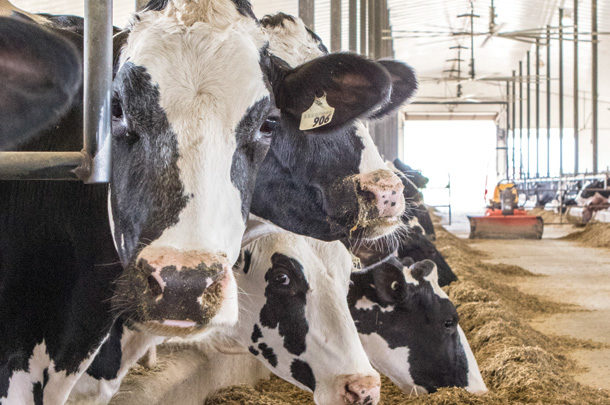It is an interesting exercise, and I am amazed by all the different ways to feed cows and still make lots of milk. While there are exceptions to every rule, there are several factors very common among this group of producers, and I will spell them out here.
Feedstuffs
Almost without exception, our 100-pound herds are feeding a highly digestible neutral detergent fiber (NDF) corn silage. These farms commonly have corn silage that exceed a 57% 30-hour NDFd (digestibility) on the forage lab test and as a group averages just over 61% on the 30-hour NDFd lab test. Typically, they also feed over 50% of their forage as this highly digestible corn silage. Most also feed a small-grain forage (rye, triticale, barley, oats) that is also highly digestible (averaging nearly 60% 30-hour NDFd). However, dry matter (DM) pounds of this feed varies greatly from 2 pounds to nearly 7 pounds. Between corn silage DM pounds and small-grain forage DM pounds, these two forages make up about 70% of forage DM in nearly all the rations. The balance of the forages is either alfalfa, alfalfa mixed with grasses, straw or sorghum, making up the rest of the 54% forage (average) ration being fed. However, feeding a ration that is high in fast-digestion NDF (fNDF) is not highly statistical when comparing fNDF to overall milk income. Income was calculated using the 5-year average for milk, butterfat and milk protein prices in the Northeast (Figure 1).

Most of the rations were also feeding a buffer, a yeast culture (or a product that has a yeast culture in it) and an ionophore. A little more than half were feeding a product with some anecdotical evidence of having some capacity as a mycotoxin binder, and just under a fourth of these farms were feeding some type of chelated trace mineral product slightly above current National Research Council (NRC) requirements. All farms had fat-soluble vitamins that exceeded NRC requirements, and several were feeding some B vitamins, mostly biotin or choline.
As rumen degradable protein (RDP) sources go, about two-thirds of farms surveyed were feeding a soya source (soybean meal, heat-treated soybean meal or roasted beans) and the other third were feeding canola. Please note at the time of the survey, canola was not priced competitively against soybean meal and may have skewed the results in favor of soy products. Several of these farms typically feed canola but changed because of the economic situation at the time of the survey. Almost all the farms were feeding some levels of urea to add to the RDP in the ration, which averaged 9.78% of the dry matter intake (DMI).
All the farms were feeding some source of a highly fermented starch, whether it was in corn silage, high-moisture corn, bakery waste, flaked corn, earlage or snaplage. All the rations had at least 18.5% of their DM as fStarch (fermentable) and averaged 20.7% of the DMI. Ironically, the amount of fStarch in the ration was highly correlated with the total milk income generated on these farms, with a very typical polynomial curve showing the law of diminishing returns (Figure 2).

Fats
Almost all the farms were feeding an added fat source of either cottonseed, roasted soybeans, distillers grains or adding more fat from soybean oil, corn oil or tallow. Also, all were feeding a source of bypass fat. Together, these increased the total fat of the rations, added more long-chain fatty acids (LCFA) and individual fatty acids. The amount of LFCA in the rations has excellent trend lines, when comparing these levels to component income production, and has a high R2 value (Figure 3).

Amino Acids
Looking at the two key amino acids in the rations showed some interesting findings. The higher the methionine and lysine levels fed, the higher the milk production. There is very good statistical correlation with the amount of metabolizable methionine fed and milk production levels. Scientific research also supports this. With current economics and the high price of protein, we are again pushing higher levels of amino acids in rations and seeing nice responses in both milk and components by pushing methionine (Figure 4).

When we look at metabolizable lysine in the rations, as compared to income generated, we also see nice trend lines showing higher levels drive more income through higher milk production and better components (Figure 5). Again, with today’s higher milk protein prices, it really pays to feed these higher levels of lysine in the rations.

These surveys always teach us something about how to improve feeding the high-producing modern dairy cow. Our 100-pound survey showed that most herds were feeding a highly digestibly forage(s) along with a fairly high level of fStarch, higher levels of LCFAs and higher levels of amino acids, especially methionine and lysine. Our next survey, later this year, will be on herds producing over 7 pounds of components consistently.

-
Steven Massie
- Head of Nutrition
- Renaissance Nutrition Inc.
- Email Steven Massie






